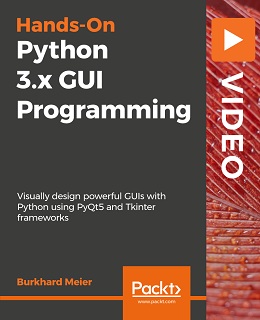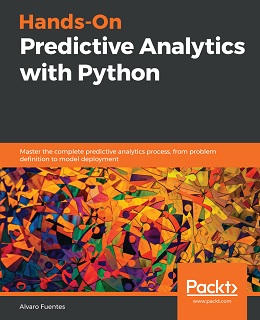| Uploader: | Ernej |
| Date Added: | 17.10.2016 |
| File Size: | 16.89 Mb |
| Operating Systems: | Windows NT/2000/XP/2003/2003/7/8/10 MacOS 10/X |
| Downloads: | 26610 |
| Price: | Free* [*Free Regsitration Required] |
hands-on markov models with python pdf Torrents Download - Limetorrents
A Markov Model is a stochastic model which models temporal or sequential data, i.e., data that are ordered. It provides a way to model the dependencies of current information (e.g. weather) with previous information. It is composed of states, transition scheme between states, . Feb 15, · Hands-On Markov Models with Python. This is the code repository for Hands-On Markov Models with Python, published by Packt. Implement probabilistic models for learning complex data sequences using the Python ecosystem. What is this book about? Hidden Markov Model (HMM) is a statistical model based on the Markov chain concept. Oct 18, · Hands-On Markov Models with Python 1st Edition Pdf Download For Free Book - By AnkurAnkan, Abinash Panda Hands-On Markov Models with Python Unleash the power of unsupervised machine learning in Hidden Markov Models using TensorFl - .

Hands-on markov models with python pdf download
A Markov chain is a mathematical system usually defined as a collection of random variables, that transition from one state to another according to certain probabilistic rules. These set of transition satisfies the Markov Hands-on markov models with python pdf downloadwhich states that the probability of transitioning to any particular state is dependent solely on the current state and time elapsed, and not on the sequence of state that preceded it.
This unique characteristic of Markov processes render them memoryless. In this tutorial, you will discover when you can use markov chains, what the Discrete Time Markov chain is. You'll also learn about the components that are needed to build a Discrete-time Markov chain model and some of its common properties. Next, you'll implement one such simple model with Python using its numpy and random libraries. You will also learn some of the ways to represent a Markov chain like a state diagram and transition matrix.
Want to tackle more statistics topics with Python? Markov Chains have prolific usage in mathematics. They are widely employed in economics, game theory, communication theory, genetics and finance, hands-on markov models with python pdf download.
They arise broadly in statistical specially Bayesian statistics and information-theoretical contexts. When it comes real-world problems, they are used to postulate solutions to study cruise control systems in motor vehicles, hands-on markov models with python pdf download, queues or lines of customers arriving at an airport, exchange rates of currencies, etc.
The algorithm known as PageRank, which was originally proposed for the internet search engine Google, is based on a Markov process. Reddit's Subreddit Simulator is a fully-automated subreddit that generates random submissions and comments using markov chains, so cool!
A Markov chain is a random process with the Markov property. A random process or often called stochastic property is a mathematical object defined as a collection of random variables.
A Markov chain has either discrete state space set of possible values of the random variables or discrete index set often representing time - given the fact, many variations for a Markov chain exists. A discrete-time Markov chain involves a system which is in a certain state at each step, with the state changing randomly between steps. The steps are often thought of as moments in time But you might as well refer to physical distance or any other discrete measurement.
A discrete time Markov chain is a sequence of random variables X 1X 2X 3Putting this is mathematical probabilistic formula:. Which means the knowledge of the previous state is all that is necessary to determine the probability distribution of the current state, satisfying the rule of conditional independence or said other way: you only need to know the current state to determine the next state.
The possible values of X i form a countable set S called the state space of the chain. The state space can be anything: letters, hands-on markov models with python pdf download, numbers, basketball scores or weather conditions. While the time parameter is usually discrete, the state space of a discrete time Markov chain does not have any widely agreed upon restrictions, and rather refers to a process on an arbitrary state space.
However, many applications of Markov chains employ finite or countably infinite state spaces, because they have a more straightforward statistical analysis. A Markov chain is hands-on markov models with python pdf download using a probabilistic automaton It only sounds complicated!
The changes of state of the system are called transitions. The probabilities associated with various state changes are called transition probabilities. A probabilistic automaton includes the probability of a given transition into the transition function, turning it into a transition matrix. Every state in the state space is included once as a row and again as a column, and each cell in the matrix tells you the probability of transitioning from its row's state to its column's state.
If the Markov chain has N possible states, the matrix will be an N x N matrix, such that entry I, J is the probability of transitioning from state Hands-on markov models with python pdf download to state J. Additionally, the transition matrix must be a stochastic matrix, a matrix whose entries in each row must add up to exactly 1.
Since each row represents its own probability distribution. So, the model is characterized by a state space, a transition matrix describing the probabilities of particular transitions, and an initial state across the state space, given in the initial distribution. When Cj is sad, which isn't very usual: she either goes for a run, goobles down icecream or takes a nap.
From historic data, if she spent sleeping a sad day away. The Markov Chain depicted in the state diagram has 3 possible states: sleep, run, icecream. So, the transition matrix will be 3 x 3 matrix. Notice, the arrows exiting a state always sums up to exactly 1, similarly the entries in each row in the transition matrix must add up to exactly 1 - representing probability distribution.
In the transition matrix, the cells do the same job that the arrows do in the state diagram. Now that you have seen the example, this should give you an idea of the different concepts related to a Markov chain. But, how and where can you use these theory in real life?
With the example that you have seen, you can now answer questions like: "Starting from the state: sleep, what is the probability that Cj will be running state: run at the end of a sad 2-day duration? Let's work this one out: In order to move from state: sleep to state: run, Cj must either stay on state: sleep the first move or daythen move to state: run the next second move 0.
So the probability: 0. Hopefully, this gave you an idea of the various questions you can answer using a Markov Chain network. Also, with this clear in mind, it becomes easier to understand some important properties of Markov chains:.
Tip : if you want to also see a visual explanation of Markov chains, make sure to visit this page. Let's try to code the example above in Python, hands-on markov models with python pdf download. And although in real life, you would probably use a library that encodes Markov Chains in a much efficient manner, the code should help you get started Let's now define the states and their probability: the transition matrix.
Remember, the matrix is going to be a 3 X 3 matrix since you have three states. Also, you will have to define the transition paths, you can do this using matrices as well.
Oh, always make sure the probabilities sum up to 1. And it doesn't hurt to leave error messages, at least when coding! Now let's code the real thing. You will use the numpy. While most of its arguments are self-explanatory, the p might not be.
It is an optional argument that lets you enter the probability distribution for the sampling set, which is the transition matrix in this case. You get a random set of transitions possible along with the probability of it happening, starting from state: Sleep. Extend the program further to maybe iterate it for a couple of hundred times with the same starting state, you can then see the expected probability of ending at any particular state along with its probability.
Note This is actually the "law of large numbers", which is a principle of probability that states that the frequencies of events with the same likelihood of occurrence even out, but only if there are enough trials or instances. In other words, as the number of experiments increases, the actual ratio of outcomes will converge on a theoretical or expected ratio of outcomes. This concludes the tutorial on Markov Chains.
You have been introduced to Markov Chains and seen some of its properties. Simple Markov chains are one of the required, foundational topics to get started with data science in Python, hands-on markov models with python pdf download.
If you'd like more resources to get started with statistics hands-on markov models with python pdf download Python, make sure to check out this page. Are you interested in exploring more practical case studies with statistics in Python? Log in. Learn about Markov Chains, their properties, transition matrices, and implement one yourself in Python! Subscribe to RSS. About Terms Privacy.
Stock Price Analysis and Parts-of-Speech Tagging with Hidden Markov Models (HMMs)
, time: 8:04Hands-on markov models with python pdf download

Oct 18, · Hands-On Markov Models with Python 1st Edition Read & Download - By AnkurAnkan, Abinash Panda Hands-On Markov Models with Python Unleash the power of unsupervised machine learning in Hidden Markov Models using TensorFl - Read Online Books at blogger.com A Markov Model is a stochastic model which models temporal or sequential data, i.e., data that are ordered. It provides a way to model the dependencies of current information (e.g. weather) with previous information. It is composed of states, transition scheme between states, . Hands-On Markov Models with Python helps you get to grips with HMMs and different inference algorithms by working on real-world problems. The hands-on examples explored in the book help you simplify the process flow in machine learning by using Markov model concepts, thereby making it accessible to everyone.

No comments:
Post a Comment